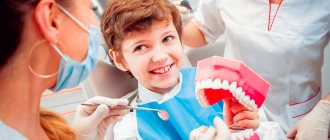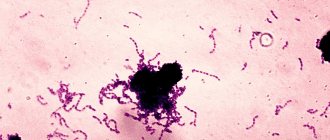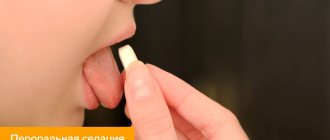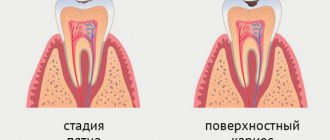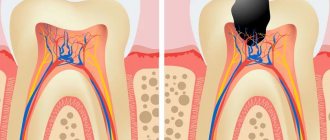- Questions and answers
- Stock
- Reviews
| Prices | Is it important to treat childhood caries? | Symptoms | Stages of caries | Treatment methods |
Caries of primary and permanent teeth occurs in 70-80% of children. This is due to the fact that children do not take good care of their oral hygiene and are partial to sweets. Do I need to treat the first teeth that will have to be removed anyway? What treatment methods are used in dentistry? How much does it cost to treat caries in children at the NovaDent clinic?
Prices
| Baby teeth | Price |
| Treatment of milk caries with placement of a filling made of glass ionomer cement | 2 350 ₽ |
| Treatment of caries with light polymerization fillings | 3 500 ₽ |
| Treatment of initial and superficial caries with Icon | 3 500 ₽ |
| Baby teeth | Price |
| Treatment of caries with filling made of glass ionomer cement | 2 350 ₽ |
| Treatment of caries with light polymerization fillings | 3 500 ₽ |
| Treatment of initial and superficial caries with Icon | 3 500 ₽ |
| Permanent teeth | Price |
| Temporary filling | 300 ₽ |
| Medical pad | 550 ₽ |
| Treatment of caries with placement of a light polymerization filling (anesthesia, cavity formation, antiseptic treatment, filling) | 2500 – 4 500₽ |
| Tooth restoration | 5 500 ₽ |
| Permanent teeth | Price |
| Temporary filling | 300 ₽ |
| Medical pad | 550 ₽ |
| Treatment of caries with placement of a light polymerization filling (anesthesia, cavity formation, antiseptic treatment, filling) | 2500 – 4 500 ₽ |
| Tooth restoration | 5 500 ₽ |
You can make an appointment with a pediatric therapist by multi-line phone or online on the website.
In our center, pediatric dentistry operates in the following clinics:
- Bratislavskaya, VDNKh, Verkhniye Likhobory, Krasnogorsk, Oktyabrskoye Pole, Petrovsko-Razumovskaya, Skhodnenskaya
How to prepare your child for treatment
It's no secret that children are afraid of dentists, and without reason. Today, dental procedures are performed quickly and painlessly. You just need to prepare your baby for treatment so that he doesn’t worry. Find a good specialist. Some doctors turn the treatment process into an interesting game and thereby distract the child from terrible thoughts.
Practice your visit to the dentist at home. Soft toys can also act as “patients”. Tell your child that both mom and dad go to the dentist. Choose a time to visit the clinic when your baby is alert and cheerful. Make up a story about how a doctor saves teeth from monsters. Never scare children with hospitals or doctors when they misbehave.
Check your child's teeth every few months. Get him used to brushing them twice a day. Buy a special children's brush with soft bristles. To make it more interesting for him to take care of his teeth, you can choose a brush stylized as a cartoon character. Similar hygiene products are available in our online store.
Why is it necessary to treat childhood caries promptly?
- Deep dental caries in children can provoke dangerous complications, pulpitis and periodontitis, acute pain and loss of a dental unit. And due to the fact that young children are not able to tolerate pain, treatment of the disease in an advanced stage must be carried out under general anesthesia or sedation.
- The rudiments of permanent units are located under the milk ones. Serious infections and early removal of primary teeth can lead to dental problems in adulthood.
- Dairy milk is more porous in its structure, so caries in children progresses faster. If treatment is not started on time, after 3-6 months a small carious spot can lead to deep caries and pulpitis.
To detect the disease at an early stage, visit the pediatric dentist once every 3-4 months.
The Forbidden fruit is sweet…
In order not to tempt your baby with “forbidden fruits,” simply do not buy them or consume them yourself. There is no doubt that your friends and relatives all bring sweets to the child solely with the best intentions. Try to talk to them and explain that instead of candy, you can bring your child, for example, a toy or an interesting book. Due to poor or complete lack of oral hygiene, the plaque that remains on the teeth after eating food turns into dental plaque containing bacteria that produce lactic acid, which damages the enamel and contributes to the development of caries. As soon as a child has his first teeth, he should immediately have age-appropriate toothpaste and a brush. Developing the habit of brushing your teeth at an early age twice a day (in the morning and also in the evening, after meals) will prevent many problems.
Symptoms of the disease
A child cannot always point out the source of pain and discomfort, so parents need to be especially attentive to their child’s behavior and monitor the condition of the oral cavity. The following symptoms should alert you:
- Refusal to eat, tearfulness while eating;
- Chewing food on only one side of the jaw;
- Painful sensations from hot, cold and sweet;
- Yellow or white spots, dark streaks on tooth enamel;
- Bad breath.
If you observe one or more of the signs listed above in your child, contact your dentist immediately.
What is bottle caries?
There is another type of childhood caries - bottle caries. It occurs in children after the eruption of baby teeth, when the baby is breastfed or bottle-fed. This disease usually occurs as a result of feeding a child before bedtime. While he sleeps, bacteria begin to multiply in his mouth.
Often this form of carious process affects the cervical area. Gradually, caries spreads along the entire circumference of the crown. First, white spots appear, then they darken and destroy dentin. The child constantly cries, especially during meals, sleeps poorly and tries to refuse food. This indicates increased sensitivity of the enamel. Left untreated, it can lead to premature loss of baby teeth.
Stages of caries
There are 4 stages of caries in primary teeth.
Elementary
– the stage of a carious stain is characterized by softening and demineralization of the enamel. The tooth surface loses its uniformity and becomes rough with white or light brown inclusions. At this stage, caries is asymptomatic.
Surface
– the destruction of the outer shell of the tooth continues, the shade of the enamel deteriorates, the nerve begins to react to temperature stimuli, sweet foods and drinks.
Average
– bacteria penetrate into the inner layers of the tooth, and the upper layers of dentin begin to deteriorate. At this stage, the carious cavity is clearly visible. Sensitivity to hot, cold and sweets increases.
Deep
– the infection spreads and affects an increasing proportion of dentin. At this stage of the disease, the risk of complications increases, including tooth loss.
What is caries: types and causes of the disease
Caries is the process of destruction of hard tooth tissues. Childhood caries develops rapidly: if in adults the transition from initial to deep caries takes years, then a child’s teeth can be affected in just a few months. As a rule, caries affects several baby teeth at once.
Types of caries of primary teeth according to the depth of damage:
- Superficial caries: a small cavity appears, the lesion affects only the tooth enamel. The child may experience sharp pain when eating sweet or sour foods. Treatment of the affected areas with fluoride-containing preparations is required.
- Medium caries characterizes the destruction of dentin. Damaged teeth react to thermal and taste stimuli. Treatment of moderate caries of primary teeth involves filling. If a tooth is loose and a permanent tooth is in a hurry to appear in its place, filling is pointless.
- Deep caries is the last stage of the disease, often accompanied by periodontitis, cyst formation, and gumboil.
Features of caries treatment in children
The dentist must treat small patients with care and choose the most gentle and painless treatment possible. In dental therapy for children, the doctor follows the following rules:
- The duration of the appointment is no more than 30 minutes
. - , application anesthesia
is mainly used , less often - infiltration anesthesia (injection). For pain relief, the same drugs are used as for adults, only in smaller doses. - Treatment of caries in young children is carried out without drilling
using gentle methods: fluoridation and the infiltration method (with the drug Icon). - To remove deep caries in children under 3 years of age, filling with glass ionomer cement or photopolymer composite is used, usually under general anesthesia or sedation.
Factors for the occurrence of caries in children under 3 years of age
There are three groups of factors: a woman’s poor lifestyle during pregnancy, local and general. If a mother does not monitor her diet during pregnancy, abuses alcohol, smokes, and does not visit doctors, the likelihood of a baby being born with various diseases increases.
Of course, he will not have caries from birth, but it can develop after teething, for example, due to a lack of minerals in the body. A pregnant woman should lead a healthy lifestyle and include the following foods in her diet: milk, cottage cheese, nuts, fish, meat, liver, legumes, berries, fruits, chicken eggs and cereals.
Among the external factors for the development of caries in children:
- Poor hygiene. Children don't like to brush their teeth. At first, adults do this for them; at about a year old, children begin to learn to clean themselves. If the baby neglects this hygienic procedure, plaque accumulates on his teeth, which gradually turns into tartar. It is a favorable environment for the proliferation of cariogenic microbes.
- Impaired saliva production. Saliva contains substances that neutralize acids produced by bacteria. If the salivary glands do not work well, producing insufficient amounts of saliva, demineralization of the enamel occurs faster.
- Malocclusion. If a child’s teeth grow in different directions and the bite develops incorrectly, more hard-to-reach places appear in the oral cavity into which microbes penetrate.
- Consumption of large amounts of sweets. Cariogenic bacteria feed on carbohydrates. The fermentation process begins in the oral cavity. Sucrose is the most dangerous for humans, fructose is less dangerous.
Common factors for caries in children include:
- cardiovascular diseases;
- problems with the gastrointestinal tract;
- weak immunity;
- bad ecology;
- stress.
Dental caries in children occurs due to the influence of several factors on the body. In children, tooth enamel is just developing. It takes 2-3 years for teeth to become stronger. They are more vulnerable to germs. In addition, children often eat sweets. All this leads to the development of caries.
Treatment methods for caries of primary teeth
Initial and superficial caries of baby teeth can be treated without a drill. In young children, carious stains on tooth enamel are effectively removed by infiltration using the unique German Icon technology. Fluoridation is also widely used.
Treatment without drilling with Icon
The technique consists of applying a special paste to a previously dried surface, which restores the enamel and stops the development of caries. Icon is completely painless and does not require anesthesia.
Indications:
usually carried out 6 months after the complete eruption of a particular tooth, suitable for children over 2 years old.
Fluoridation
Treatment of the tooth surface with fluoride-containing pastes with calcium, which restore enamel. Remineralization is an effective, painless and absolutely safe procedure. Thanks to fluoridation of children's teeth, the enamel layer becomes denser and less vulnerable to the negative effects of bacteria and acids, which cause dental caries.
Indications:
used from an age when the child is able not to swallow the medicinal solution.
Fissure sealing
The essence of the method is filling grooves and tubercles on the tooth surface with special fluorine-containing materials. The technique protects against the penetration of pathogenic bacteria into the tooth and reduces the likelihood of caries by 90%. Fissure sealing is carried out in two ways: invasive and non-invasive.
Indications:
It is advisable to carry out no later than 2.5-3 years.
Important:
All treatment procedures are carried out only after professional cleaning of baby teeth.
Read more about the treatment of baby teeth.
Causes of caries
Most often, caries of primary teeth can form under the influence of several factors simultaneously. Its most common causes are:
- Damage to tooth germs in the prenatal period. In the embryo, tooth buds begin to form in the first trimester of pregnancy. That is why any illnesses of the expectant mother that she suffered during this period, as well as the use of medications, can contribute to the fact that the fetus’s proper development of teeth is disrupted.
- Insufficient oral hygiene or its absolute absence. In this case, food particles remain on the teeth, and this is an excellent environment for the life and proliferation of bacteria.
- Incorrect eating habits - using pacifiers for a long time. Those children who are unable to switch from drinking from a bottle to a sippy cup or cup for a long time, and especially those who have learned to fall asleep every evening with a bottle or pacifier in their mouth, are at risk of developing bottle caries. With this pathology, through prolonged contact with the teeth of the liquid from the bottle (especially if it is sweet), the front teeth are affected by caries, and the process spreads along the circumference of the crown part of the tooth (along the perimeter of its visible part).
- Insufficient amounts of food in the daily diet, which requires intense chewing and leads to increased salivation, due to which the teeth are cleaned naturally. This factor is inherent in children under two years of age; it is one of the causes of early caries.
- Lack of calcium in food and water - the main building material of teeth and fluorides, which strengthen tooth enamel and protect against caries, preventing the possibility of its development.
- Rickets – with this pathology in children, tooth tissue is easily destroyed.
- Physiologically determined low resistance of children's dental tissue to agents that cause caries.
- Anomalies of dentition and bite.
- Hereditary predisposition.
- Chronic diseases, as well as frequent respiratory diseases, which reduce the overall resistance of the body.
- Excessive amounts of carbohydrates in a child’s food contribute to the development of caries in two ways simultaneously: they feed bacteria, and in the process of their decay, organic acids are formed that damage tooth enamel. For the formation of caries, it is not so much the total amount of carbohydrates consumed that matters, but the frequency of their intake.
Without a doubt, a child who is not yet three years old should not snack between meals, especially food containing a high amount of carbohydrates (sweets, chocolate, etc.). Instead, it is better to offer your baby fruits, marshmallows, marmalade, pastries, and dried goods. It is better to eat sweets after breakfast or dinner, and then brush your teeth after a while. Almost all children do not grow up without sweets, but their consumption should be limited and reasonable.
Treatment of caries of permanent teeth in children
At the initial stage, caries of permanent teeth can also be cured without drilling or preparation. The same methods are used as in the treatment of primary teeth. Sealing the fissures of molar teeth is recommended as the most effective prevention of caries.
Filling is the main method of treating permanent teeth in children. Filling technology for children is practically no different from therapy for adults. For restoration in this case, photopolymer composites of the latest generation are more often used.
The permanent tooth is filled according to the following scheme:
- Preparation, cleaning of carious cavity;
- Treatment with an antiseptic drug;
- Restoration with photopolymer composite;
- Polishing and grinding of the filling.
Tooth restoration is carried out under local anesthesia. Doses are selected individually depending on the age of the child.
Complications
The enamel of baby teeth is not strong enough, and therefore even minor damage to the tooth by caries can lead to rapid destruction of tooth tissue. The most common complication of caries in primary teeth is pulpitis. As a rule, the disease is chronic and appears even in the presence of small carious cavities. Only a dentist can identify the disease, since despite the inflammatory process, the child does not experience discomfort for a long time.
If pulpitis is not treated, the complication develops into a more complex form; the infection affects the tissues surrounding the tooth root - periodontitis develops. Parents should regularly take their child for preventive examinations to the dentist, since advanced caries of baby teeth can lead to serious complications and cause the death of the permanent tooth germ.
Special offer
Participate in the promotion
Promotion “1+1”: child and parent
You have entrusted NovaDent with the treatment of your child’s teeth, as a token of gratitude we are giving you a free consultation with any specialist (surgeon, implantologist, therapist, orthodontist, hygienist), as well as an orthopantomogram (panoramic photograph of the teeth) sent by email.
Take time for your health and take advantage of this great offer! Participate in the promotion
Expert of the article you are reading: Lapshina Maria Aleksandrovna Dentist, pediatrician
21 years
Clinical experience
Krasnogorsk
Moscow region, Krasnogorsk, Podmoskovny Boulevard, 5
+7
Free consultation with this specialist
